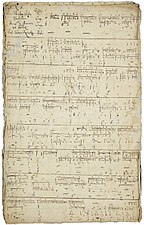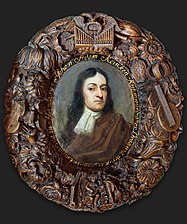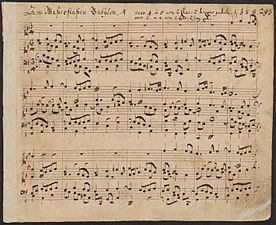m Dating maintenance tags: {{More footnotes}} |
Francis Schonken (talk | contribs) →Musical settings: a few problems with this section |
||
| Line 176: | Line 176: | ||
== Musical settings == |
== Musical settings == |
||
{{Multiple issues|section=yes| |
|||
{{Confusing section|reason= the 1720 improvisation by Bach before Reincken is told twice without integration in the narrative|small=no}} |
|||
{{incomplete section|small=no}} |
|||
}} |
|||
In 1544 [[Georg Rhau]] composed two settings for several parts for his collection ''Neue Deutsche Geistliche Gesänge für die gemeinen Schulen''.<ref name="Scroll" /> [[Sigmund Hemmel]] used the text in the 1550s in his four-part setting of the psalms, with the cantus firmus in the tenor, which was printed in 1569.<ref name="Scroll" /> |
In 1544 [[Georg Rhau]] composed two settings for several parts for his collection ''Neue Deutsche Geistliche Gesänge für die gemeinen Schulen''.<ref name="Scroll" /> [[Sigmund Hemmel]] used the text in the 1550s in his four-part setting of the psalms, with the cantus firmus in the tenor, which was printed in 1569.<ref name="Scroll" /> |
||
Revision as of 05:10, 22 March 2018
| "An Wasserflüssen Babylon" | |
|---|---|
| Lutheran hymn | |
 Cantus and verses of An Wasserflüssen Babylon[1] | |
| Text | Wolfgang Dachstein |
| Language | German |
| Based on | Psalm 137 |
| Published | 1525 |
"An Wasserflüssen Babylon" (By the rivers of Babylon) is a Lutheran hymn by Wolfgang Dachstein, which was first published in Strasbourg in 1525. The text of the hymn is a paraphrase of Psalm 137. Its singing tune, which is the best known part of the hymn and Dachstein's best known melody, was popularised as chorale tune of Paul Gerhardt's 17th-century Passion hymn "Ein Lämmlein geht und trägt die Schuld". With this hymn text, Dachstein's tune is included in the Protestant hymnal Evangelisches Gesangbuch.
Various composers adopted the hymn or its tune in their compositions. Johann Schein and Heinrich Schütz published four-part chorale settings of the hymn in the first half of the 17th century. Johann Adam Reincken wrote an extensive organ piece based on the hymn. Johann Sebastian Bach, who copied Reincken's composition in 1700, and twenty years later was commended by Reincken for improvising on the organ on "An Wasserflüssen Babylon", composed a chorale prelude on the hymn as part of his Great Eighteen Chorale Preludes.
History and context

The Lutheran hymn "An Wasserflüssen Babylon" is a closely paraphrased versification of Psalm 137, "By the rivers of Babylon", a lamentation for Jerusalem, exiled in Babylon. Its text and melody, Zahn number 7663, first appeared in Strasbourg in 1525 in Wolf Köpphel's Das dritt theil Straßburger kirchenampt. This Strasbourg tract, which comprised the third part of the Lutheran service, is now lost.[2][3] As directed by the Lutheran reformer Martin Bucer, the service contained a liturgical agenda and rhyming psalms.[4][5]
The text and melody of "An Wasserflüssen Babylon" are attributed to the organist Wolfgang Dachstein.[2][6][7] The hymn was rapidly distributed—it was printed in Martin Luther's 1545 Babstsches Gesangbuch[8]—and spread to most Lutheran hymnbooks by central Germany.[2] After the Sack of Magdeburg (1631) it was decreed that Dachstein's 137th Psalm would be sung every year as part of the ceremonies to commemorate the destruction of the city.[9]
The melody of the hymn became better known than its text, through the association of that melody with Paul Gerhardt's 17th-century Passion hymn "Ein Lämmlein geht und trägt die Schuld".[3][9] With that hymn text, the hymn tune of "An Wasserflüssen Babylon" is adopted as EG 83 in the Protestant hymnal Evangelisches Gesangbuch.[10][11] The hymn tune is Dachstein's best known composition.[7]
Miles Coverdale provided an early English translation in the Tudor Protestant Hymnal "Ghostly Psalms and Spiritual Songs," 1539.[12][13]
Text
The Lutheran text of Wolfgang Dachstein first appeared in Strasbourg in 1525 in Wolf Köpphel's Das dritt theil Straßburger kirchenampt.[2] The early Tudor verses from the "Ghostly Psalms and Spiritual Songs," 1539, originate in Myles Coverdale, Bishop of Exeter, and are Lutheran versifications that Coverdale wrote in continental Europe while in exile from England.[14][13]
|
German text |
English translation |
|
1. An Wasserflüssen Babylon, |
At the ryvers of Babilon, |
|
2. Die uns gefangen hielten lang |
They that toke us so cruelly, |
|
3. Wie sollen wir in solchem Zwang |
To whome we answered soberly: |
|
4. Ja, wenn ich nicht mit ganzem Fleiss, |
Yee, above all myrth and pastaunce, |
|
5. Die schnöde Tochter Babylon, |
O thou cite of Babilon, |
Musical settings
In 1544 Georg Rhau composed two settings for several parts for his collection Neue Deutsche Geistliche Gesänge für die gemeinen Schulen.[16] Sigmund Hemmel used the text in the 1550s in his four-part setting of the psalms, with the cantus firmus in the tenor, which was printed in 1569.[16]
Johann Hermann Schein published his four-part setting of "An Wasserflüssen Babylon" in 1627,[17][citation needed] a setting that was republished in p. 706 of Vopelius's Neu Leipziger Gesangbuch.[2][18][citation needed] In 1628 Heinrich Schütz published a four-part setting of "An Wasserflüssen Babylon", SWV 242, in his Becker Psalter, Op. 5.[1][19]
The melody was frequently used for organ settings in the 17th century, such as a chorale fantasia by the Hamburg organist Johann Adam Reincken.[citation needed] The extended work has 320 bars, and takes about 19 minutes to perform.[citation needed] Every line is composed differently, in the style of the North German organ school.[citation needed] The young Johann Sebastian Bach copied Reincken's work when he studied with Georg Böhm in 1700. Bach's copy, in organ tablature, was rediscovered in 2005 at the Herzogin Anna Amalia Bibliothek in Weimar. This copy is one of two of Bach's oldest extant manuscripts.[20]
Bach wrote a setting the third of his Great Eighteen Chorale Preludes (BWV 653).[21][22]
An Wasserflüssen Babylon, BWV 653, is a paraphrase of Psalm 137, a sorrowful lament of the Israelites, exiled in Babylon. Bach's two monumental Passions are heard in the closing choruses in the same kind of melancholic dance-like music as the third chorale of the "Great Eighteen". After bar 48, the musical development, particularly the chromaticism, becomes more concentrated, creating a mood of pathos. The use of the reprise at the start of the ritornello, without any variants, is unusal and might have been unintentional during the preparation of the manuscript. Stinson's describes Bach's improvised performance in 1720 at the organ loft of St. Catherine's Church, Hamburg with a well-known comment of the 97-year-old Reinken quoted in The New Bach Reader of David, Mendel & Woolf: "I thought that this art was dead, but I see that in you it still lives." The coda in Bach's BWV 653 shares many compositional features of some of Reinken's fantasias (see the two musical excerpts appended); as Stinson suggests, this might have been some form of musical homage to Reinken. In Bach's closing pedal point in the lower alto manual, the upper manual develops the two-part ritornello accompanied during 4 bars of pedal; in the next 2 bars, there is a double pedal before the fermata; during the ritornello motives of the upper manual, the tension is ingeniously and peacefully resolved through contrary motion in rising and falling scales in the middle voices, ruffled only by a passing major seventh.[22]
Although BWV 653 was composed in Leipzig within the traditions of Thuringia, Bach's contemplative mood is far removed from his earlier improvisatory compositions. As Geck (2006) recounts, in 1720 Bach is known to have extemporised at Hamburg for almost half an hour at the organ in front of the nonagenerian Reinken, who stated that, "I thought that art has died out, but I see that it lives on in you." By contrast, the style of Bach's later chorale prelude is understated with its alto cantus firmus subtly embellished.[23]
Bach also composed a four-part setting, BWV 267, which appeared around 1735 in the Dietel manuscript.[24][25] That harmonisation is found as well in G major and in A-flat major in 18th-century chorale collections, both as "An Wasserflüssen Babylon" and as "Ein Lämmlein geht und trägt die Schuld".[25] For instance, its publication in the Breitkopf edition of the 1780s has it as No. 5 in G major under the former title and as No. 308 in A-flat major under the latter title.[25]
-
Title page of the Psalmen Davids, 1628[26]
-
Johanniskirche in Lüneburg where Böhm was principal organist and Bach studied music
-
Portrait of Johann Adam Reincken, 1674
-
Autograph manuscript from start of Bach's An Wasserflüssen Babylon, BWV 653
-
Coda of BWV 653
-
First page of Bach's BWV 653b with two manuals and a double organ (doppio pedale)
Further reading
- Eduard Emil Koch: Geschichte des Kirchenlieds und Kirchengesangs der christlichen, insbesondere der deutschen evangelischen Kirche. Vol. 8: Zweiter Haupttheil: Die Lieder und Weisen. Stuttgart: Belser, 1876 (3rd edition), pp. 526–528. Template:Lang icon
Notes
- ^ a b Schütz 1628
- ^ a b c d e Leahy 2011, pp. 37–38, 53
- ^ a b Zahn 1891
- ^ Greschat 2004, pp. 55–64
- ^ Trocmé-Latter 2015, pp. 3, 11
- ^ Terry 1921, pp. 101–103
- ^ a b Julian 1907
- ^ Krummacher 2001, pp. 194–195
- ^ a b Werner 2016, p. 205
- ^ Axmacher, Elke; Fischer, Michael (2002). "83 – Ein Lämmlein geht und trägt die Schuld". In Hahn, Gerhard; Henkys, Jürgen (eds.). Liederkunde zum Evangelischen Gesangbuch. Göttingen: Vandenhoeck & Ruprecht. pp. 60–70. ISBN 978-3-52-550326-3.
{{cite book}}:|work=ignored (help) - ^ "Ein Lämmlein geht und trägt die Schuld" (in German). Württembergische Landeskirche. Retrieved 24 February 2018.
- ^ Coverdale 1846, pp. 571–572
- ^ a b Terry, Charles Sanford. "Bach's Chorals. Part III: The Hymns and Hymn Melodies of the Organ Works". oll.libertyfund.org. Retrieved 24 February 2018.
- ^ Coverdale 1846, pp. 571–572
- ^ Modernised orthography, while the original wording is found in Philipp Wackernagel: Das deutsche Kirchenlied von der ältesten Zeit bis zu Anfang des 17. Jahrhunderts. Vol. III. Teubner, 1870, No. 135 (p. 98)
- ^ a b "An Wasserflüssen Babylons". The Scroll Ensemble. Retrieved 3 March 2018.
- ^ Johann Hermann Schein (1627). Cantional, Oder Gesangbuch Augspurgischer Confession. Leipzig: Schein, pp. 325–327
- ^ Gottfried Vopelius (1682). Neu Leipziger Gesangbuch. Leipzig: Christoph Klinger, pp.706–709
- ^ Schütz 2013
- ^ Adler, Margit (31 August 2006). "Earliest Music Manuscripts by Johann Sebastian Bach Discovered". www.klassik-stiftung.de. Klassik Stiftung Weimar.
- ^ Williams 2003, pp. 347–351
- ^ a b Stinson 2001
- ^ Geck 2006, pp. 507–509
- ^ D-LEb Peters Ms. R 18 (chorale collection Dietel) at Bach Digital website. 6 August 2017.
- ^ a b c Luke Dahn. BWV 267 at www
.bach-chorales .com. 2017. - ^ Schütz 2013, pp. 55–65
References
- Axmacher, Elke; Fischer, Michael (2002), "83 – Ein Lämmlein geht und trägt die Schuld", in Hahn, Gerhard; Henkys, Jürgen (eds.), Liederkunde zum Evangelischen Gesangbuch (in German), vol. 5, Göttingen: Vandenhoeck & Ruprecht, pp. 60–70, ISBN 978-3-52-550326-3
- Bach, J.S. (1986), Bighley, Mark S. (ed.), The Lutheran Chorales in the Organ Works of J.S. Bach, Concordia Publishing House, ISBN 0570013356
{{citation}}: Cite has empty unknown parameter:|1=(help) - Bach, J.S. (1999), David, Hans T.; Mendel, Arthur; Wolff, Christoph (eds.), The New Bach Reader: A Life of Johann Sebastian Bach in Letters and Documents, W.W. Norton, ISBN 0393319563
{{citation}}: Cite has empty unknown parameter:|1=(help) - Werner, Wilfried (2016). "'Nicht mitzuhassen, mitzulieben bin ich da!' Exegese und Predigt zu Psalm 137". In Hartlapp, Johannes; Cramer, Andrea (eds.). "Und was ich noch sagen wollte ...": Festschrift für Wolfgang Kabus zum 80. Geburtstag (in German). Frank & Timme. pp. 193–216. ISBN 3732903133.
{{cite book}}: Invalid|ref=harv(help) - Bach, J.S. (2006), Maul, Michael; Wollny, Peter (eds.), Weimarer Orgeltabulatur. Die frühesten Notenhandschriften Johann Sebastian Bachs sowie Abschriften seines Schülers Johann Martin Schubart. Mit Werken von Dietrich Buxtehude, Johann Adam Reinken und Johann Pachelbel, Documenta musicologica, Bärenreiter Facsimile, vol. II/39, translated by J. Bradford Robinson on pp. XXI-XXXIII, Bärenreiter, ISBN 9783761819579
- Beißwenger, Kirsten (2016), "Other Composers", in Leaver, Robin A (ed.), The Routledge Research Companion to Johann Sebastian Bach, translated by Emerson Morgan, Taylor & Francis, p. 237–264, ISBN 1315452804
- Coverdale, Miles (1846), "Ghostly Psalms and Spiritual Songs", in Pearson, George (ed.), Remains of Myles Coverdale, Parker Society, vol. 14, Cambridge University Press, pp. 571–572
- Greschat, Martin (2004), "A Preacher in Strasbourg", Martin Bucer: A Reformer and His Times, translated by Stephen E. Buckwalter, Westminster John Knox Press, pp. 47–86, ISBN 0-664-22690-6
- Geck, Martin (2006), Johann Sebastian Bach: Life and Work, translated by John Hargraves, Houghton Mifflin Harcourt, ISBN 0151006482
- Herl, Joseph (2008), "Strasbourg", Worship Wars in Early Lutheranism: Choir, Congregation and Three Centuries of Conflict, Oxford University Press, pp. 96–100, ISBN 0195365844
- Honders, Casper (1985), Over Bachs schouder... (in Dutch), Niemeijer, ISBN 9060623002
- Julian, John (1907), A Dictionary of Hymnology, Dover Publications, pp. 277–278
- Krummacher, Christoph (2001), "Leipziger Gesangbuch 1545", in Herbst, Wolfgang (ed.), Wer ist wer im Gesangbuch?, Handbuch Zum Evangelischen Gesangbuch (in German), vol. 2, Vandenhoeck & Ruprecht, pp. 194–195, ISBN 3525503237
- Küster, Konrad (1996), "Musik an der Schwelle des Dreißigjährigen Krieges: Perspektiven der Psalmen Davids von Heinrich Schütz", Schütz-Jb, 18: 39–51
- Leahy, Anne (2011), "An Wasserflüssen Babylon", J. S. Bach's "Leipzig" Chorale Preludes: Music, Text, Theology, Contextual Bach Studies, vol. 3, Scarecrow Press, pp. 37–58, ISBN 0810881810
- Rifkin, Joshua; Linfield, Eva; McCulloch, Derek; Baron, Stephen (2001). "Schütz, Heinrich". Grove Music Online (8th ed.). Oxford University Press. ISBN 978-1-56159-263-0. Retrieved 12 March 2018.
- Schütz, Heinrich (1628), "Der CXXXVII. Psalm", Psalmen Davids: Hiebevorn in Teutzsche Reimen gebracht durch D. Cornelium Beckern (in German), Freiberg: Georg Hoffman, pp. 560–564. RISM 00000990058712
{{citation}}: External link in|postscript=|postscript=at position 3 (help)CS1 maint: postscript (link) - Schütz, Heinrich (2013). A Heinrich Schütz Reader: Letters and Documents in Translation. Translated by Johnston, Gregory S. United States: Oxford University Press. p. 62. ISBN 0199812209.
{{cite book}}: Invalid|ref=harv(help) - Snyder, Kerala Y.; Johnson, Gregory S. (2001). "Schein, Johann Hermann". Grove Music Online (8th ed.). Oxford University Press. ISBN 978-1-56159-263-0. Retrieved 12 March 2018.
- Spagnoli, Gina (1993), "Dresden at the Time of Heinrich Schütz", in Price, Curtis (ed.), The Early Baroque Era: From the late 16th century to the 1660s, Macmillan, pp. 164–184
- Stinson, Russell (2001), J.S. Bach's Great Eighteen Organ Chorales, Oxford University Press, p. 78–80, ISBN 0-19-516556-X
- Stinson, Russel (2012), J. S. Bach at His Royal Instrument: Essays on His Organ Works, Oxford University Press, p. 16, ISBN 019991723X
- Terry, Charles Sanford (1921), Bach's Chorals, vol. III, pp. 101–104
- Trocmé-Latter, Daniel (2015), "Abolishing the Mass", The Singing of the Strasbourg Protestants, 1523-1541, St Andrews Studies in Reformation History, Ashgate, pp. 43–114, ISBN 9781472432063
- Varwig, Bettina (2011), Histories of Heinrich Schütz, Cambridge University Press, ISBN 1139502018
- Williams, Peter (1980), The Organ Music of J.S. Bach, Volume II: BWV 599–771, etc., Cambridge Studies in Music, Cambridge University Press, ISBN 0-521-31700-2
- Williams, Peter (2003), The Organ Music of J. S. Bach (2nd ed.), Cambridge University Press, ISBN 0-521-89115-9
- Williams, Peter (2016), Bach: A Musical Biography, Cambridge University Press, ISBN 1107139252
- Yearsley, David (2009), "Bach Discoveries", Early Music, 37: 489–492
- Yearsley, David (2012), Bach's Feet: The Organ Pedals in European Culture, Cambridge University Press, pp. 94–97, ISBN 1139500112
- Zahn, Johannes (1891), "7663", Die Melodien der deutschen evangelischen Kirchenlieder (in German), vol. IV, Gütersloh: Bertelsmann, pp. 508–509
{{citation}}: External link in|volume=
External links
- An Wasserflüssen Babylon, Opella nova (Geistliche Konzerte, Leipzig, 1618) by Johann Hermann Schein: Scores at the International Music Score Library Project
- Johann Hermann Schein / An Wasserflüssen Babylon / aus: Opella Nova (1618), Teil 1 / 1617 Carus
- An Wasserflüssen Babylon, Becker Psalter, Op.5 (Psalmen Davids, Freiberg, 1628) by Heinrich Schütz: Scores at the International Music Score Library Project
- An Wasserflüssen Babylon, P.17, An Wasserflüssen Babylon, P.18, An Wasserflüssen Babylon, P.20 by Johann Pachelbel: Scores at the International Music Score Library Project
- An Wasserflüssen Babylon (Complete Organ Works, ed. Klaus Beckmann, Breitkopf & Härtel, 1974) by Johann Adam Reincken: Scores at the International Music Score Library Project
- An Wasserflüssen Babylon, BWV 267, BWV 653, by Johann Sebastian Bach: Scores at the International Music Score Library Project
- Zu Fassungen der Melodie in Elsässischen Gesangbüchern colmarisches.free.fr
- Glebe, Karl ; Heinermann, Otto: / Vorspiele zum deutsch-evangelischen Gesangbuch für Orgel dzb.de
- G. W. Fink: No. 24 Allgemeine musikalische Zeitung, Volume 38, 1836
![Title page of the Psalmen Davids, 1628[26]](https://upload.wikimedia.org/wikipedia/commons/thumb/c/cb/Cornelius-Becker-Heinrich-Sch%C3%BCtz%2C-Psalmen-Davids-1628.jpg/133px-Cornelius-Becker-Heinrich-Sch%C3%BCtz%2C-Psalmen-Davids-1628.jpg)





